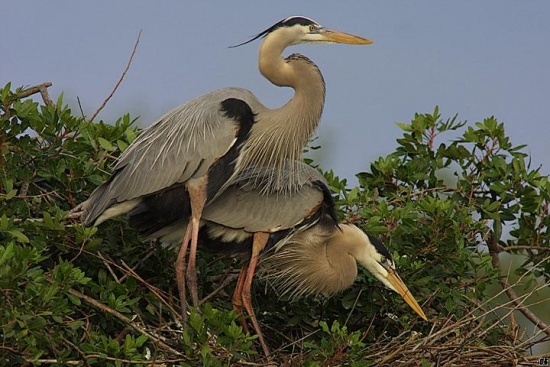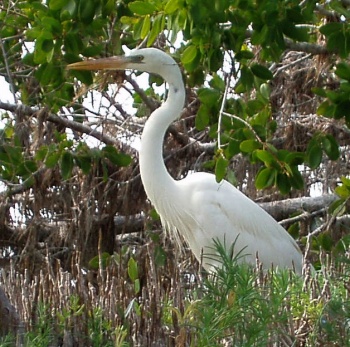Nomdeploom (talk | contribs) m (add reference for subspecies) |
Nomdeploom (talk | contribs) (add photo of white morph) |
||
| Line 13: | Line 13: | ||
===="Great White" Heron==== | ===="Great White" Heron==== | ||
There is also an all white version of the Great Blue Heron, the "Great White" Heron, that can be found in southern [[Florida]]. It has yellow legs, a yellow bill and white feathers. | There is also an all white version of the Great Blue Heron, the "Great White" Heron, that can be found in southern [[Florida]]. It has yellow legs, a yellow bill and white feathers. | ||
| + | [[Image:d05_105.jpg|thumb|350px|right|Great White Heron. Photo by {{user|nomdeploom|nomdeploom}} <br/>Location: [[Everglades National Park]], [[Florida]].]] | ||
Similar to [[Great Egret]]. | Similar to [[Great Egret]]. | ||
Revision as of 00:35, 5 May 2009
- Ardea herodias
Identification
The largest heron in North America
Ht. 3-4 ft
W. 6ft
- Blue-gray feathers on most of its body
- Plume of feathers on its chest and back during breeding
- Long, pointed yellow bill
- Long legs
- Adults have white on the top of their heads and long black plumes above their eyes.
"Great White" Heron
There is also an all white version of the Great Blue Heron, the "Great White" Heron, that can be found in southern Florida. It has yellow legs, a yellow bill and white feathers.
Similar to Great Egret.
Distribution
It is found throughout most of North America, including Alaska, Quebec and Nova Scotia. The range extends south through Florida, Mexico and the Caribbean to South America. Very rare vagrant to the Azores and United Kingdom.
Migrates in the fall, although some stay in the northern part of their range.
Taxonomy
Five subspecies are recognized[1]:
- A.h. fannini - SE Alaska to coastal Washington
- A.h. herodias - S. Canada to s Baja California and Central America
- A.h. wardi - S-central USA to Gulf Coast and Florida
- A.h. occidentalis - S. Florida through West Indies to islands off Venezuela
- A.h. cognata - Galapagos Islands
Habitat
Margins of lakes and slow-flowing rivers, swamps and marshes, frequently on sea-coasts, in estuaries and mangroves.
Behaviour
Usually tucks its head into an S-shape when it is resting and flying.
References
- Clements, James F. 2007. The Clements Checklist of Birds of the World. 6th ed., with updates to October 2007. Ithaca: Cornell University Press. ISBN 9780801445019





